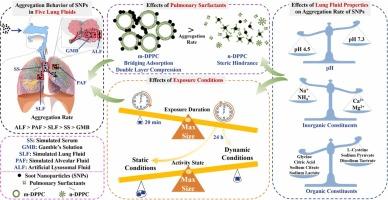Aggregation kinetics of diesel soot nanoparticles in lung fluids: Effects of exposure conditions, fluid properties, and pulmonary surfactant lipids
IF 11.3
1区 环境科学与生态学
Q1 ENGINEERING, ENVIRONMENTAL
引用次数: 0
Abstract
Soot nanoparticles (SNPs) are carbonaceous particulate matter with significant environmental and health impacts. Once inhaled, their aggregation in the respiratory system can influence their migration patterns and health hazards. This study investigated the effects of exposure conditions (interaction time, particle concentration, and activity state), fluid properties (pH and composition), and pulmonary surfactant lipids [micro-sized (m-DPPC) and nano-sized dipalmitoylphosphatidylcholine (n-DPPC)] on aggregation kinetics of SNPs in five lung fluids. Early-stage aggregation rates ranked artificial lysosomal fluid (0.64 nm/s) > simulated alveolar fluid (0.20 nm/s) > simulated lung fluid (0.17 nm/s) > simulated serum (0.11 nm/s) > Gamble’s solution (0.03 nm/s), indicating potential SNP migration into the lower respiratory tract and alveolar interstitial spaces. Increasing particle concentration and reducing pH both promoted aggregation. Under static conditions, SNPs formed larger aggregates (397.8–5441 nm) than dynamic conditions (209.7–2461 nm) across all lung fluids over 24 h. Aggregation was driven by Ca2 +, Mg2+, citric acid, sodium lactate, sodium citrate, and glycine. Among two lipids, m-DPPC facilitated aggregation through charge neutralization and bridging adsorption, while n-DPPC inhibited aggregation via steric hindrance, consistent with the modified Derjaguin-Landau-Verwey-Overbeek (MDLVO) theory. These findings underscore the significant impact of lung fluids on migration and risks of SNPs in respiratory systems.

柴油烟尘纳米颗粒在肺液中的聚集动力学:暴露条件、流体特性和肺表面活性剂脂质的影响
碳纳米颗粒(SNPs)是一种具有重大环境和健康影响的碳质颗粒物。一旦吸入,它们在呼吸系统中的聚集会影响它们的迁移模式和健康危害。本研究考察了暴露条件(相互作用时间、颗粒浓度和活性状态)、流体性质(pH和组成)和肺表面活性物质脂质[微米级(m-DPPC)和纳米级双棕榈酰磷脂酰胆碱(n-DPPC)]对五种肺液体中snp聚集动力学的影响。人工溶酶体液早期聚集率(0.64 nm/s) >;模拟肺泡液(0.20 nm/s) >;模拟肺液(0.17 nm/s) >;模拟血清(0.11 nm/s);甘布尔溶液(0.03 nm/s),表明SNP可能迁移到下呼吸道和肺泡间隙。增加颗粒浓度和降低pH值都能促进聚集。在静态条件下,SNPs在24小时内在所有肺液中形成更大的聚集体(397.8-5441 nm),而在动态条件下(209.7-2461 nm)。聚集是由Ca2+、Mg2+、柠檬酸、乳酸钠、柠檬酸钠和甘氨酸驱动的。在两种脂质中,m-DPPC通过电荷中和和桥接吸附促进聚集,而n-DPPC通过位阻抑制聚集,符合改进的Derjaguin-Landau-Verwey-Overbeek (MDLVO)理论。这些发现强调了肺液对呼吸系统中snp迁移和风险的重要影响。
本文章由计算机程序翻译,如有差异,请以英文原文为准。
求助全文
约1分钟内获得全文
求助全文
来源期刊

Journal of Hazardous Materials
工程技术-工程:环境
CiteScore
25.40
自引率
5.90%
发文量
3059
审稿时长
58 days
期刊介绍:
The Journal of Hazardous Materials serves as a global platform for promoting cutting-edge research in the field of Environmental Science and Engineering. Our publication features a wide range of articles, including full-length research papers, review articles, and perspectives, with the aim of enhancing our understanding of the dangers and risks associated with various materials concerning public health and the environment. It is important to note that the term "environmental contaminants" refers specifically to substances that pose hazardous effects through contamination, while excluding those that do not have such impacts on the environment or human health. Moreover, we emphasize the distinction between wastes and hazardous materials in order to provide further clarity on the scope of the journal. We have a keen interest in exploring specific compounds and microbial agents that have adverse effects on the environment.
 求助内容:
求助内容: 应助结果提醒方式:
应助结果提醒方式:


